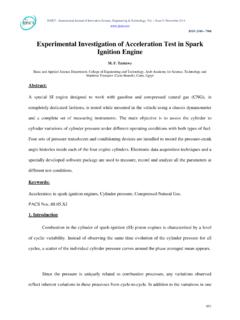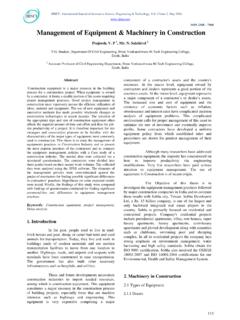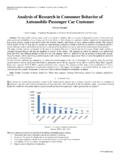Transcription of Generation Cost Calculation for 660 MW Thermal Power …
1 IJISET - International Journal of Innovative Science, Engineering & Technology, Vol. 1 Issue 10, December 2014. ISSN 2348 7968 660 Generation cost Calculation for 660 MW Thermal Power Plants Vilas S. MotghareP1*P, R. K. ChamP2P P1 PMaharashtra State Power Generation Company Ltd. Koradi, Nagpur-441111, ( ), INDIA P2 PSindhu Mahavidyalaya, Nagpur, ( ), INDIA Abstract: The Central Electricity Regulatory Commission (CERC) has the Power of deciding the tariff for electricity generated by various Power stations. Tariff is calculated on the basis of capacity charge (fixed cost ) and energy charge (variable cost ). The various components of capacity charge on which the tariff depends are return on equity, interest on capital loan, depreciation, interest on working capital, operation & maintenance cost , cost of secondary oil. The components of energy charge are primary fuel costs, secondary fuel oil consumption and auxiliary energy consumption.
2 Tariffs are classified into Nominal, Discount and Levelized tariff. Tariff calculations for 660 MW Thermal Power plants have been discussed. Keywords: Electricity Act, Electricity tariff, Plant load factor, fixed and variable cost . : The Electricity Act (supply) 1948 has been replaced by Electricity Act 2003 by Government of INDIA. According to this act, the rights of determination of tariffs, for the Power generated by central, state and private Power generating stations, based on specific terms and conditions has been given to the Central Electricity Regulatory Commission (CERC). Section 61 of the Act empowers the Commission to specify and regulate the terms and conditions for determination of tariff in accordance with the provisions of the said section along with the National Electricity Policy and Tariff Policy.
3 As per the Electricity Act 2003, the CERC in March 2004, had put forth tariff regulations for the FY 2004-09 and on expiry of this, CERC had notified new tariff regulations on January 19, 2009 for the next regulatory period FY 2009-14. The new regulations were applicable to all Power generating stations (excluding stations based on non-conventional energy sources) and transmission licensees, except those entities which are determined through bidding process in accordance with the guidelines issued by the Central Government. 2. Regulatory Norms for calculations of Power Tariff Tariff for Power generated by various Power stations is decided on the basis of Capacity charge or fixed cost Energy charge or variable cost Components of Capacity Charges/ Fixed Charge: Table 1. Components of Capacity Charges for FY 2009-2014 Component of Capacity Charges/ fixed cost FY 2009-2014 a Return on Equity b Interest on Capital Loan As per actual c Depreciation d Interest on Working Capital Based on normative parameters e Operation & maintenance cost Based on normative parameters f cost of Secondary Oil Based on normative parameters (a)Return on Equity (RoE) CERC has specified a Pre-Tax RoE of for the tariff period FY 2009-14.
4 Further, it has allowed an additional RoE of for projects commissioned after April 2009 within specific timelines. The additional RoE allowed by CERC is acting as an incentive for a project developer to achieve time-bound milestones. On the other hand, the Tariff Regulations does not allow utilities to recover tax on income such as unscheduled interchange (UI) and incentive income from beneficiaries. IJISET - International Journal of Innovative Science, Engineering & Technology, Vol. 1 Issue 10, December 2014. ISSN 2348 7968 661 (b) Interest on Capital Loan The CERC has specified a debt-equity ratio of 70:30 as the funding mix for the capital cost of a project. The interest on debt funds is recoverable as part of the tariff. The Tariff Regulations allows retention of 1/3rd of the benefits, if any, arising out of re-financing of loans; earlier such benefits were required to be passed on entirely to the beneficiaries.
5 (c) Depreciation In the Regulations for the earlier tariff periods, the CERC followed the concept of Advance Against Depreciation (AAD) in case where the normal depreciation rates (notified by the regulator) were not sufficient to meet the debt repayment obligation of the utility. The Tariff regulations for the period FY 2009-14 the CERC has removed the concept of AAD and at the same time increased the depreciation rates applicable for projects as against the earlier deprecation rate of for Thermal Power projects (based on a 25-year project life and 90% of the capital cost ), the CERC has increased the depreciation rate to for most components of the project (d) Interest on Working Capital The working capital for a Thermal Power station is given in table 2. Table 2. Working capital for Thermal Power station for FY 2009-2014 Components FY 2009-14 1 Coal Stock 1 Months for Pit Head 2 Months for Non-Pit Head 2 Secondary Fuel Oil Stock 2 Months 3 Maintenance Spares 20% of O&M Costs Coal Based 30% of O&M Costs Gas Based 4 Sales Receivables 2 Months 5 O&M expenses 1 Month (e) Operations & Maintenance Costs (O&M) The CERC has specified O&M Costs for Thermal Power stations on the normative parameters (Rs.)
6 Lakh/MW), depending on the class of the machine installed by the Power station. The normative O&M expenses allowed are given in table 3. Table 3. Operations & Maintenance Costs for different capacity Power plants. Rs Lakh/MW 200/210/250 MW 300/330/350 MW 500 MW 600 MW and Above 2009-10 2010-11 2011-12 2012-13 2013-14 (f) cost of Secondary Fuel Oil As per Tariff regulations for the period FY 2009-14, the CERC has included the cost of SFO as part of AFC. Projects are able to recover the cost of SFO on the basis of normative consumption norms specified by the regulator and the plant availability factor during the year. Energy Charges (for recovery of Primary fuel costs) Energy charges for Thermal Power stations are linked to the normative operational parameters as specified by the regulator. The normative parameters are given in table 4.
7 Table. 4 Normative Operational Parameters for Coal based Thermal Power Projects Norms for Operations FY 2009-14 1 Plant Availability Factor 85% 2 Gross Station Heat Rate For existing Stations 200/210/250 MW Sets 2500 500 MW and above 2425 3 Secondary Fuel Oil Consumption Coal Based ml/Kwh 4 Auxiliary Energy Consumption 200 MW Series 500 MW Series(Steam driven BFP) 500 MW Series( Power driven BFP) IJISET - International Journal of Innovative Science, Engineering & Technology, Vol. 1 Issue 10, December 2014. ISSN 2348 7968 662 3. General Concepts & Definitions in reference to Tariff Calculation Auxiliary energy consumption The quantum of energy consumed by auxiliary equipment of the generating station, and transformer losses within the generating station, expressed as a percentage of the sum of gross energy generated at the generator terminals of all the units of the generating station.
8 Date of Commercial Operation or COD The date declared by the generating company after demonstrating the maximum continuous rating (MCR) or the installed capacity (IC) through a successful trial run after notice to the beneficiaries, from 0000 hour of which scheduling process as per the Indian Electricity Grid Code (IEGC) is fully implemented, and in relation to the generating station as a whole, the date of commercial operation of the last unit or block of the generating station. Declared capacity The capability to deliver ex-bus electricity in MW declared by such generating station in relation to any time-block of the day or whole of the day, duly taking into account the availability of fuel or water, and subject to further qualification in the relevant regulation. Gross calorific value The heat produced in kcal by complete combustion of one kilogram of solid fuel or one litre of liquid fuel or one standard cubic meter of gaseous fuel, as the case may be.
9 Gross station heat rate The heat energy input in kcal required to generate one kWh of electrical energy at generator terminals of a Thermal generating station. Infirm Power Electricity injected into the grid prior to the commercial operation of a unit or block of the generating station. Installed capacity The summation of the name plate capacities of all the units of the generating station or the capacity of the generating station (reckoned at the generator terminals) approved by the Commission from time to time. Operation and maintenance expenses The expenditure incurred on operation and maintenance of the project, or part thereof, and includes the expenditure on manpower, repairs, spares, consumables, insurance and overheads. Plant availability factor (PAF) The average of the daily declared capacities (DCs) for all the days during that period expressed as a percentage of the installed capacity in MW reduced by the normative auxiliary energy consumption.
10 Conversion of MW into Million Units (MUs) 1 MW = 1MW x 365days x 24hours xPLFx100010,00,000 Tariffs Nominal tariff Discount Tariff Levelized Tariff Nominal Tariff: The tariff calculated at for each year (fixed cost + variable cost ) Discount Tariff: The tariff calculated at present value of the future tariffs. This is done by discounting future tariffs by discount rate (given by CERC) Discount tariff = Nominal tariff x Discount factor Levelized tariff: The tariff calculated for all years. This is a simple tariff representing the tariffs throughout the plant life. In concept, this is Weighted Mean of all tariffs with weights as discounting factors. Levelized Tariff = Nominal Tariff x Discount Rate Discount rate Where, i varies from 1 to n. n is the life of plant in years 1. The nominal tariff for the next year may be calculated by individually calculating for each year taking into consideration of future value of oil, coal etc.











